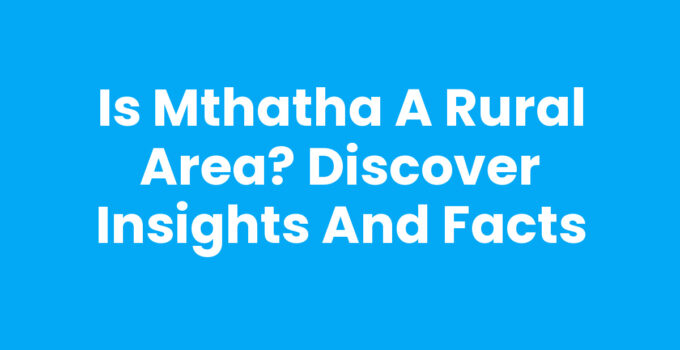Situated in the Eastern Cape province of South Africa, Mthatha has often led to discussions surrounding its classification as a rural or urban area. This blog post aims to provide insights into the geographical, cultural, and economic aspects of Mthatha, thus clarifying whether it can be defined as a rural area.
Is Mthatha A Rural Area?
To address the question, ‘Is Mthatha A Rural Area?’, it is essential to evaluate various factors, including population density, infrastructure, and economic activities.
Mthatha, known historically as Umtata, plays a vital role within the Eastern Cape. It serves not only as a town but also as a municipality. The following detailed examination will provide comprehensive insights into how Mthatha fits into the rural-urban spectrum.
Geography and Population
Mthatha is strategically located in the eastern part of South Africa, surrounded by beautiful landscapes typical of the region. With a population of approximately 100,000 residents, the town exhibits traits of semi-urban areas more so than purely rural settings. The population density is relatively high compared to many rural towns, indicating a more urban lifestyle.
Infrastructure Development
The infrastructure in Mthatha further complicates its classification. Unlike rural areas which often lack basic services, Mthatha has a range of amenities, including government offices, schools, hospitals, and shopping centers. This level of infrastructure development supports both the urban and rural population.
Economic Activities
The economic landscape is another factor to consider when discussing Mthatha’s classification. With numerous small businesses, shops, and markets, alongside governmental and educational institutions, Mthatha has a mixed economy. This diversity mirrors more urban settings, and as such, the economic influence challenges the notion of Mthatha being strictly rural.
Related Guide: How to Fix My Phone In Mthatha: A Comprehensive Guide
Benefits of Mthatha’s Classification
Understanding whether Mthatha is a rural area can lead to various benefits:
- Planning and Development: Proper classification helps in planning infrastructure and services.
- Access to Funding: Recognizing Mthatha as a semi-urban area can attract more funding and development initiatives.
- Community Development: Acknowledgment of its economic potential can result in focused community projects.
See Also: Is Mthatha A City Or A Town? Discover the Truth Behind It
Important Considerations
When considering Mthatha’s classification, other factors must be kept in mind:
- Cultural Heritage: Mthatha is rich in cultural history, being closely associated with figures such as Nelson Mandela. This heritage enhances its urban profile.
- Rural Communities Nearby: Surrounding areas may still retain a rural essence due to their low population density and reliance on agriculture.
- Socio-economic Development: Challenges like unemployment and poverty are still prevalent, calling into question the viability of purely urban classification.
In summary, Mthatha embodies aspects of both rural and urban environments. While it has characteristics such as a significant population and developed infrastructure, it also retains elements of rural lifestyle influenced by nearby communities. Therefore, classifying Mthatha as solely rural would overlook its complex identity.
In conclusion, Mthatha represents a unique blend of characteristics that merit recognition as a semi-urban area rather than purely rural. Understanding this classification is vital for addressing the needs and opportunities of its residents.
You Might Also Like: Buy A Car In Mthatha: Essential Tips and Considerations
Frequently Asked Questions
What are the main characteristics of Mthatha?
Mthatha features a developed infrastructure, a diverse economy, and a blend of urban and rural traits, making it semi-urban.
How does Mthatha's economy function?
Mthatha supports a mix of small businesses, governmental services, education, and healthcare, creating a varied economic landscape.
Why is the classification of Mthatha important?
Understanding Mthatha's classification helps in planning urban development, attracting funding, and addressing community needs.









